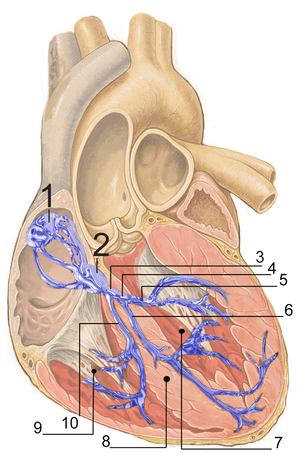Pre-excitation syndrome
| Pre-excitation syndrome | |
|---|---|
 | |
Electrical conduction system of the heart. (Accessory pathways not shown.)
| |
| Classification and external resources | |
| Specialty | cardiology |
Pre-excitation syndrome is an abnormal heart rhythm in which the ventricles of the heart become depolarized too early, which leads to their partial premature contraction.
Pathophysiology
Normally, the atria and the ventricles are electrically isolated, and electrical contact between them exists only at the "atrioventricular node". In all pre-excitation syndromes, at least one more conductive pathway is present. Physiologically, the normal electrical depolarization wave is delayed at the atrioventricular node to allow the atria to contract before the ventricles. However, there is no such delay in the abnormal pathway, so the electrical stimulus passes to the ventricle by this tract faster than via normal atrioventricular/bundle of His system, and the ventricles are depolarized (excited) before (pre-) normal conduction system. This creates the ventricular pacemaker type of ectopic pacemaker.
Types
Several types of pre-excitation syndrome have been described.[1]
| Type | Conduction pathway | PR interval | QRS interval | Delta wave? |
| Wolff-Parkinson-White syndrome | Bundle of Kent (atria to ventricles) | short | long | yes |
| Lown-Ganong-Levine syndrome | "James bundle" (atria to bundle of His) | short | normal | no |
| Mahaim-type | Mahaim fibers | normal | long | no |
References
- ↑ "General principles of asynchronous activation and preexcitation". Retrieved 2009-08-12.
External links
| Classification |
|---|